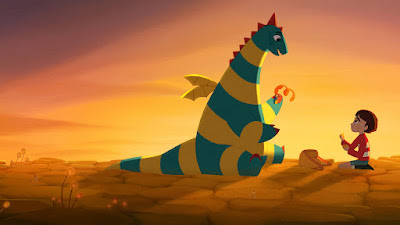All the same, it's rather a pity that the screenplay (by Meg LeFauve, one of the megabrains behind Inside Out) should default to quest-narrative standard: the film is essentially a lively walk through the jungle in search of life lessons. The source material may have been dusted down now because of its vision of a child handed the unenviable responsibility of warding off disastrous ecological collapse; fleeing the mainland with the world already weighing heavy on his shoulders, Elmer winds up having to play structural engineer with Boris so as to try and prevent the island from sinking into the sea. Again, it's not Madagascar-jolly, exactly: the jolliness is mixed in with a certain degree of pedagogy. Part of me actually itched to get off the island, which in 2022 feels like a pretty stock if not archetypal location for an animated children's film, and back to that city, which feels richer in narrative possibility and sources of potential tension. (We may do yet: Gannett's book was the first in a series, and I'm eager to see how Boris tests the no-pets rule in Elmer's apartment building.) Still, at every stage, in every corner, there is undeniable art in the presentation. As in her earlier work under the auspices of Cartoon Saloon, director Nora Twomey draws big, pleasing effects from what look comparatively simple, cut-out-and-keep character designs; there's none of the clutter, gratuitous flashiness or draining overcomplication that have dogged Pixar's digimations in recent years. The relief and charm My Father's Dragon inspires lies in encountering an animation that looks (skilfully) handturned rather than 3D printed, that finds some equivalent in its method to Aardman's fingerprints-in-the-plasticine approach. Ruth Stiles Gannett is still with us, at the grand old age of 99: if she sees Twomey's film, and you hope she does, she'll surely observe that her creations have been treated with the utmost care and delicacy.
My Father's Dragon is now streaming on Netflix.

No comments:
Post a Comment